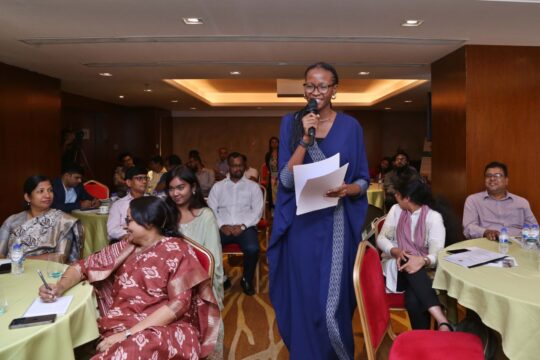Nepal Disaster Resilient Network (NDRNet), a member of Nepal Preparedness Partnership (NPP), has organized the orientation on Disaster Risk Reduction and Management in collaboration with Koholpur Municipality of Banke District, Nepal on 18-19 February 2023. With the key essence of the Asian Preparedness Partnership’s (APP) main goal ‘’safer and well-prepared communities through locally-led Disaster Risk Management actions, that disaster impacts on at-risk communities of Asia will be reduced”, the orientation sessions were conducted to build the capacity of CSO, LHOs, and local-government staff at the local level. The event was chaired by Mr. Purna Prasad Acharya, Mayor, Kohalpur Municipality, and with the presence of special guest Deputy Mayor Mrs. Sangita Subedi. The program was led by the municipality and supported by NPP, sharing the resources from both, in a collaborative way. The aim of the orientation was to capacitate the NDR Net province-level committee members (Lumbini and Sudurpashchim provinces), the ward representative of Kohalpur Municipality, and other representatives from local organizations. The sessions of the program focused on the topics of DRM issues and Early Warning Systems; Forecast Based Early Actions (Anticipatory Action); Standard Operating Procedures for Anticipatory Action in the respective municipalities and provinces. The sessions were delivered by the experts – Mr. Man Thapa, Ms. Puja Shakya, Mr. Nahakul KC, and Mr. Sher Bahadur Raule. There was a total of 34 participants in the training out of which 10 were female and 24 were male.

In the welcome remarks from the mayor, he appreciated the collaborative efforts by NPP in conducting the orientation program together with the municipality to address the issues in disaster risk management as well as disaster preparedness and climate resilience. The mayor emphasized that disaster can occur at any time so this collaborative effort would be much beneficial for preparedness and response well in advance, and this partnership approach should be continued in the future as well. Moreover, he stated that the municipality is interested and would like to welcome working together with NDRNet and NPP members in the future for effective disaster preparedness and response.
Key Achievements:
- The participants got ideas and exposure to the disaster risk management Terminologies and how those terminologies are applied in Nepal in the field of DRM.
- The participants expressed their appreciation for making them understand on early warning system and forecast-based early actions of the disasters by using effective and appropriate training approaches and tools.
- The resource person and the experts tried well to share and improve the knowledge of the participants about the legal provisions of DRM in Nepal and mainstream them in the development plans and interventions.
- The event also provided an opportunity for the reformation of the NDRNet’s Sudurpaschim province committee, with a total of 11 members in the committee
- The participants were oriented, through group work and learning sharing approach, on the Local Disaster and Climate Resilient Plans Preparation Process and local level DRR-related policy documentation. A live and useful discussion was held with concerned authorities in the participants’ team.
The program also had a session on sharing the feedback from the participants where they clearly shared their views and suggestions. The most common suggestion was the time period of the orientation to be made for additional days to have more discussion and exercises. The participants are also expected to have a certificate for the training program. Another interesting suggestion shared by the participants was to plan for an exposure visit to observe the Early Warning System (EWS) established in Nepal, its functionality, and other innovations in EWS by the Department of Hydrology and Meteorology and other stakeholders, which is to have the practical knowledge on how it functions and experience the importance of it too.
It was shared by the municipality as well as the participants of the event that this kind of orientation and training are more required and necessary at the province as well as district and local (municipal) levels. There is an inevitable need to raise awareness among communities and people who are in disaster-prone areas. It is believed that awareness is one of the major ways to stay safe from any type of disaster. According to the National Strategic Action Plan for Disaster Risk Reduction 2018-2030, Nepal is one of the disaster-prone countries with a large number of people killed annually and loss of property worth millions, positioning itself as the 11th most vulnerable country to earthquakes and floods and the 30th most vulnerable country to landslides, and also is one of the 20 most disaster-prone countries in the world. With this context, the participants of the program also realized the importance and need of such awareness/orientation/training programs to keep themselves updated and aware on the current disaster context and available preparedness and response tools and approaches.
Disaster mitigation is now a major challenge in Nepal. Given such a disaster-related scenario, there is now a need to mainstream DRR and CCA in all planning and implementation mechanisms in a collaborative manner. All the levels of government bodies, together with other partners and stakeholders/actors, need to work collaboratively and need to be concerned about disaster risk management. It was shared clearly by the participants and the municipality that the partnership approach of NPP/APP is commendable and should continue to work together with local governments too. For this, all the local governments need to be empowered and their coping capacity should be increased and they should be made aware of disaster preparedness and response.


